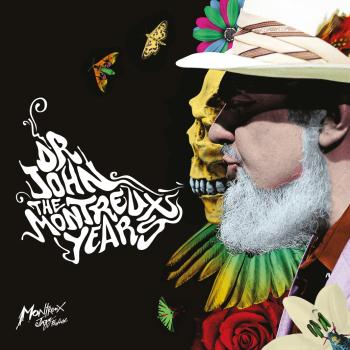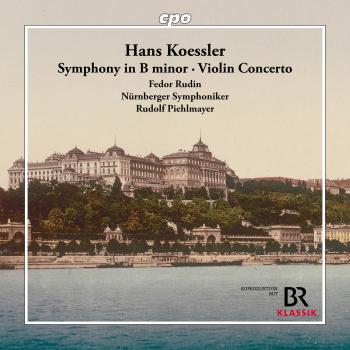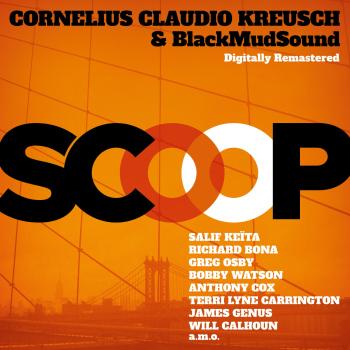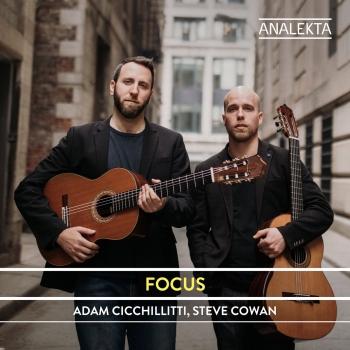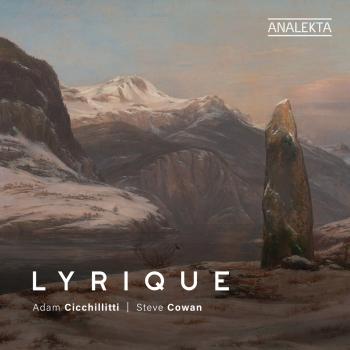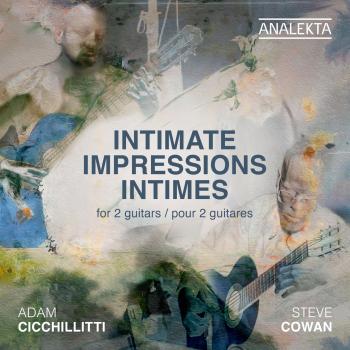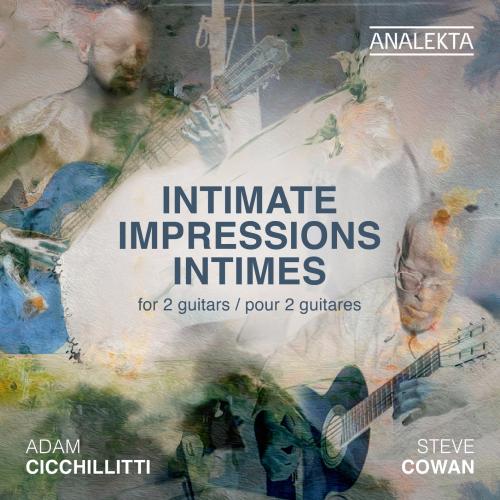
Intimate Impressions for 2 Guitars Adam Cicchillitti & Steve Cowan
Album Info
Album Veröffentlichung:
2021
HRA-Veröffentlichung:
07.11.2025
Label: Groupe Analekta, Inc
Genre: Guitar
Subgenre: Classical Guitar
Interpret: Adam Cicchillitti & Steve Cowan
Komponist: Maurice Ravel (1875-1937), Federico Mompou (1893-1987), Germaine Tailleferre (1892-1983), Claude Debussy (1862-1918), Andre Jolivet (1905-1974)
Das Album enthält Albumcover
- Maurice Ravel (1875 - 1937): Sonatine, M. 40:
- 1 Ravel: Sonatine, M. 40 (Arr. for 2 Guitars by Adam Cicchillitti and Steve Cowan): I. Modéré 04:02
- 2 Ravel: Sonatine, M. 40 (Arr. for 2 Guitars by Adam Cicchillitti and Steve Cowan): II. Mouvement de Menuet 03:03
- 3 Ravel: Sonatine, M. 40 (Arr. for 2 Guitars by Adam Cicchillitti and Steve Cowan): III. Animé: III. Animé 04:36
- Federico Mompou (1893 - 1987): Musica Callada:
- 4 Mompou: Musica Callada: I. Angelico (Arr. for 2 Guitars by Adam Cicchillitti and Steve Cowan) 01:58
- 5 Mompou: Musica Callada : V. Legato metallico (Arr. for 2 Guitars by Adam Cicchillitti and Steve Cowan) 02:25
- 6 Mompou: Musica Callada: XI. Allegretto (Arr. for 2 Guitars by Adam Cicchillitti and Steve Cowan): V. Legato metallico 01:19
- 7 Mompou: Musica Callada: XVI. Calme (Arr. for 2 Guitars by Adam Cicchillitti and Steve Cowan) 02:13
- 8 Mompou: Impresiones intimas: VIII. Secreto (Arr. for 2 Guitars by Adam Cicchillitti and Steve Cowan) 02:44
- Germaine Tailleferre (1892 - 1983): Sonate pour harpe seule:
- 9 Tailleferre: Sonate pour harpe seule (Arr. for 2 Guitars by Adam Cicchillitti and Steve Cowan): I. Allegretto 02:59
- 10 Tailleferre: Sonate pour harpe seule (Arr. for 2 Guitars by Adam Cicchillitti and Steve Cowan): II. Lento 04:05
- 11 Tailleferre: Sonate pour harpe seule (Arr. for 2 Guitars by Adam Cicchillitti and Steve Cowan): III. Perpetuum Mobile 03:08
- Claude Debussy (1862 - 1918): Préludes, Livre 2, L. 123:
- 12 Debussy: Préludes, Livre 2, L. 123: No. 5; Bruyères (Arr. for 2 Guitars by Adam Cicchillitti and Steve Cowan) 02:57
- 2 Arabesques, L. 66:
- 13 Debussy: 2 Arabesques, L. 66: No. 1, Andantino con moto (Arr. for Guitar by Eduardo Baranzano, Ricardo Izquierdo and Adam Cicchillitti) 05:25
- Préludes, Livre 1, L. 117:
- 14 Debussy: Préludes, Livre 1, L. 117: No. 8, La fille aux cheveux de lin (Arr. for Guitar by Laszlo Vereczkey) 02:47
- André Jolivet (1905 - 1974): Sérénade:
- 15 Jolivet: Sérénade: I. Praeludio e canzone 03:03
- 16 Jolivet: Sérénade: II. Allegro trepidante 03:12
- 17 Jolivet: Sérénade: III. Andante malinconico 03:42
- 18 Jolivet: Sérénade: IV. Con allegria 02:37
- Maurice Ravel: Pavane pour une infante défunte, M. 19:
- 19 Ravel: Pavane pour une infante défunte, M. 19 (Arr. for Guitar by Tristan Manoukian) 06:37
- Le Tombeau de Couperin, M. 68:
- 20 Ravel: Le Tombeau de Couperin, M. 68: I. Prélude (Arr. for 2 Guitars by Drew Henderson and Michael Kolk) 03:25
Info zu Intimate Impressions for 2 Guitars
This recording is composed of music originally written for piano, harp, or two guitars by leading 20th century composers who spent the bulk of their careers working in Paris. The arrangements, the majority of which are by the Cicchillitti/Cowan duo, eloquently illustrate that the tone colours, intimacy, and pure lyricism of the composers' styles are ideally suited to the guitar, and that the harmonic language translates beautifully to a guitar duo.
The recording also bears witness to the striking contrasts in compositional styles of the period and of the individual composers. So-called impressionist, neoclassical, neoromantic, or surreal tendencies all had their adherents, as this recording reveals. Compare the sensorial lyricism of Claude Debussy to the very personal neoclassical style of Maurice Ravel or the improvisatory and intimate miniatures of Federico Mompou to the biting wit and deliciously spicy character of Germaine Tailleferre's music. It is also a wonderful opportun- ity to savour the dissonance and polytonality of André Jolivet's Sérénade, the only original work for two guitars included in this highly attractive recording.
In 1903, the Anglo-French magazine Weekly Critical Review launched a composition competition for the first movement of a piano sonata. Ravel began to compose what would become the first movement, "Modéré," of his Sonatine. After the magazine folded, Ravel added two more movements to his competition piece to complete his Sonatine. The work is taut, bright and transparent, with a light texture that makes it ideal for transcription for two guitars. The first movement - "Modéré-doux et espressif" - has a well-structured sonata form, albeit utilizing Ravel's very personal harmonic colouring. The second movement - "Mouvement de menuet" - is an uncomplicated minuet that blossoms beautifully at its conclusion. The work closes with an undulating virtuosic movement marked "Animé."
The Catalan composer Federico Mompou was born in Barcelona in 1893 but studied, lived, and composed in Paris for much of the interwar period. Mompou's music is introspective and highly personal, inspired by popular dance and folksong. Often tinged with melancholy, the music is dreamy and impressionistic but always melodic and colourful. MuÌsica callada (literally "silent music") is a cycle of 28 exquisite miniatures for piano that Mompou composed over the 16 years from 1951 to 1967 and that were published in four volumes between 1959 and 1976. As well as being the most ambitious of his works for solo piano, it is considered Mompou's masterpiece, and he himself believed that it contained "the essence of my aesthetic conception." The first volume contains nine pieces composed in 1951 and premiered in 1952 but not published until 1959. The opening movement, "Angelico," is a refined and nostalgic evocation of a time past, described by Mompou thusly: "This music of the angels is the first music of MuÌsica callada, the music of the first Sonic Solitude, which hovers dreamily between the earth and the sky ." The fifth of the pieces is entitled simply "Legato metallico" and bears the inscription "The distant bell which [...] strikes its haunting notes seems to come from another world." The second volume, published in 1962, contains a lively and evocative 11th piece called "Allegretto," while the final piece of the set is a nostalgic and moving piece entitled "Calme."
Composed in 1911, the Quatro Quejas (Four Complaints) that form the first movements of Mompou's Impresiones intimas (Intimate Impressions) represent one of the composer's earliest completed compositions. Four more movements, including the beautiful and haunting "Secreto" (Secret) date from 1914. The work as a whole, and "Secreto" in particular, illustrates his self-termed style of "primitivism."
Germaine Tailleferre was the only woman member of the surrealist and avant-garde group of compos- ers known as Les Six. Tailleferre had a particular affinity for the harp, which prompted the legendary harpist Nicanor Zabaleta to commission a harp sonata from her. The resulting three-movement work, which displays the instrument's numer- ous expressive possibilities, has become one of Tailleferre's most popular works. The exuberant opening "Allegretto" is followed by a wistful and nostalgic "Lento" that sets up the concluding "Perpetuum mobile / Allegro gaiement." This final and flamboyant movement is highly virtuosic and technically demanding. Tailleferre's musical palette also reveals an array of sensuous harmonies. One also hears the influence of the Spanish habanera, American jazz, and even Ravel's Piano Concerto in G.
The pieces from Debussy's second book of Préludes for solo piano, composed between 1910 and 1913, are similar in intent to those from the first book. The fifth of these preludes, "BruyeÌ€res" (Heaths), is essentially pastoral in character and takes us to the moors of the Scottish Highlands, its nostalgic melody tinged with solitary melancholy. Both in structure and harmony, this prelude has a folksong-like mood that recalls "La fille aux cheveux de lin" from Book I.
Claude Debussy composed his Deux arabesques between 1888 and 1891, when he was still in his 20s. Of the Baroque arabesque, he wrote, "that was the age of the ‘wonderful arabesque,' when music was subject to the laws of beauty inscribed in the movements of Nature herself." Consequently, Debussy seems to wander through modes and keys, and achieves highly evocative impressions of nature through music. This celebrated and delightful arabesque inspired an equally delightful arrangement for solo guitar.
Intimately linked to "BruyeÌ€res," "La fille aux cheveux de lin" (The Girl with the Flaxen Hair), is the simplest and perhaps best known of all Debussy's Préludes. It traces its title and atmosphere to a verse from the French poet Charles Marie Leconte de Lisle's PoeÌ€mes antiques: Chansons écossaises. The pentatonic melody recalls the Javanese gam- elan music that so intrigued Debussy. His radiant music captures the emotional, sensorial spirit of de Lisle's poem, which tells of a young Scottish girl singing of her simple, unaffected love in the morning sunshine.
André Jolivet is often regarded as French music's most sophisticated primitivist. With Olivier Messiaen and Daniel Lesur, he was a member of the Jeune France movement, a group of composers who wanted to "create a living music in a spirit of sincerity, generosity and artistic consciousness." In the 1950s, he turned his attention to the guitar, or rather two guitars. In a personal way, Jolivet set out to change how guitar music was written. "It's quite evident that although I appreciate the guitar, I have never tried to compose in a certain sui generis style. On the contrary, my aim was to introduce new harmonies and expressions from the contemporary syntax up to now unknown to the guitar." His first work for guitar, Sérénade, is an attractive and compelling work in four movements that is essentially neoclassical in form and inspiration, especially in the noble "Praeludio e canzone" and the poetic and touching "Andante malinconico." Sérénade was dedicated to the Ida Presti/Alexandre Lagoya guitar duo and premiered in 1959.
Maurice Ravel described Pavane pour une infante défunte as "an evocation of a pavane that a little princess [Infanta] might, in former times, have danced at the Spanish court." The pavane is a slow processional dance that enjoyed great popu larity in the courts of Europe during the 16th and 17th centuries. In many ways, the piece expresses a nostalgic enthusiasm for Spanish customs and sensibilities. Ravel suggested that "at the same time as making the accompaniment secondary to the tune, you must insist on the latter's slightly mechanical aspect."
Ravel began composing a suite for piano in October 1914, a month after the start of the Great War, and completed the work entitled Le tombeau de Couperin in 1917. Each of its six movements is dedicated to a friend who died at the front. What had started as a tribute to a golden era in French music - the age of François Couperin and the 18th century in general - instead pays gentle tribute to the victims of World War I. Le tombeau de Couperin is about memory, not combat. It evokes those it honours, not the tragic circumstances of their deaths. Ravel borrows the forms of the Baroque dance suite, beginning with a "Prélude" that sets the prevailing and pervasively graceful tone of simplicity. (Richard Turp November, 2020)
"New additions to the guitar duo repertoire: 20th Century French works arranged for two guitars, artistically performed by Canadian guitarists who clearly have command of transcription skills, and also a unified delivery of the music in all its technical complexity and musical depth. Drew Henderson and Michael Kolk’s arrangement of the `Prelude’ from Ravel’s Tombeau de Couperin, the only arrangement in the program not by the duo, is nothing short of stellar in concept and execution. There follows the almost obligatory contemporary work on the program, Serenade by Andre Jolivet. Even though it was written for and premiered by Presti & Lagoya, an inspiring duo from the mid-1900s not known for avante-garde musical excursions, it disrupts the flow in this otherwise delightful program of warm and uplifting music. Liner notes by Richard Turp are well written and interesting, leaving the listener with a fairly complete picture of the music." (American Record Guide)
Adam Cicchillitti, classical guitar
Steve Cowan, classical guitar
Adam Cicchillitti
There were several media accolades over the past years for Montreal-born guitarist Adam Cicchillitti. The renowned American magazine Classical Guitar called him “a virtuoso at the top of his game” and CBC Music described him as an “ardent ambassador for classical guitar,” including him on their list of the top 30 musicians in Canada under 30 years old. Adam has commissioned over two dozen new works since 2019 and recorded five albums with the Analekta, Atma, and Leaf Music record labels. His album Focus, dedicated to new Canadian music for two guitars, was awarded “Classical Recording of the Year” at the East Coast Music Awards in 2021. The follow-up album Intimate Impressions was nominated in the same category in 2022.
Adam and his duo partner Steve Cowan have won the second and third prizes at the Guitar Foundation of America International Ensemble Competition in 2023 and 2021 respectively, without a doubt the world’s most prestigious guitar ensemble competition. Moreover, he is only the second guitarist to win the grand prize of the multi-instrument Canimex concerto competition in Canada and has been a finalist and multiple prize-winner in over a dozen national and international competitions.
Adam has set a benchmark in classical guitar with his award-winning recordings, competition performances, arrangements, and teaching. He regularly collaborates with many of Canada's most esteemed soloists and orchestras, including guitarist Steve Cowan, flutist Lara Deutsch, baritone Philippe Sly, bandoneonist Denis Plante, the Orchestre classique de Montréal and Forestare. He has toured Canada and the United States several times and has been represented by prestigious touring agencies such as Prairie Debut, Debut Atlantic, and Jeunesses Musicales. In 2022, he commissioned six new guitar concertos with the Thirteen Strings orchestra of Ottawa, again with Cowan. The works will be recorded as world premieres in 2024.
Adam is lecturer of guitar at Mount Allison University in New Brunswick, Canada. He holds a doctorate in guitar performance from McGill University and is the founder of the guitar school at Ottawa Suzuki Strings. Adam is sponsored by Augustine Strings and plays a guitar by the Canadian/Dutch luthier Sergei de Jonge.
Steve Cowan
Described as “an elegant musician whose strong, crisp sense of rhythm under-pins his colourful interpretations” (American Record Guide), the Canadian guitarist Steve Cowan has performed throughout Canada, the United States, Europe, and New Zealand. International highlights from recent seasons include concerto performances with Ensemble Del Arte (Germany), the Christchurch Symphony Orchestra (New Zealand), and two solo albums with HR Recordings (Spain).
As a chamber musician, Steve performs regularly with Forestare, a Montréal-based string ensemble. His duo with guitarist Adam Cicchillitti has premièred 21 new works and released an album of Canadian music titled FOCUS (Analekta, 2019), which won Classical Recording of the Year at the 2021 East Coast Music Awards. Their next recording, Impressions intimes (Analekta, 2021), features original arrangements of Debussy, Ravel, Mompou and Tailleferre. As of 2022, Steve is also the newest member of the renowned Canadian Guitar Quartet.
Steve has won awards at ten national and international competitions, eight of which are first prizes. Most recently, he won First Prize at the Tallinn Guitar Competition in Estonia, making him a EuroStrings touring artist for the 2021 season. Also a distinguished teacher, Steve has given public masterclasses at the Conservatorium van Amsterdam, the Royal Danish Academy of Music, the University of Victoria, the New Zealand School of Music, and more.
Originally from St. John’s, Newfoundland, Steve Cowan holds degrees from Memorial University, the Manhattan School of Music, and McGill University. His teachers include Sylvie Proulx, David Leisner and Jérôme Ducharme. Since 2019, he has been a guitar instructor at the Schulich School of Music of McGill University.
Dieses Album enthält kein Booklet

